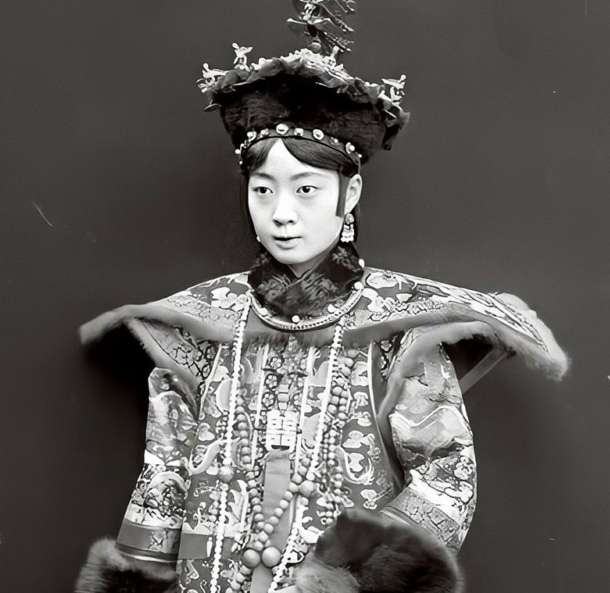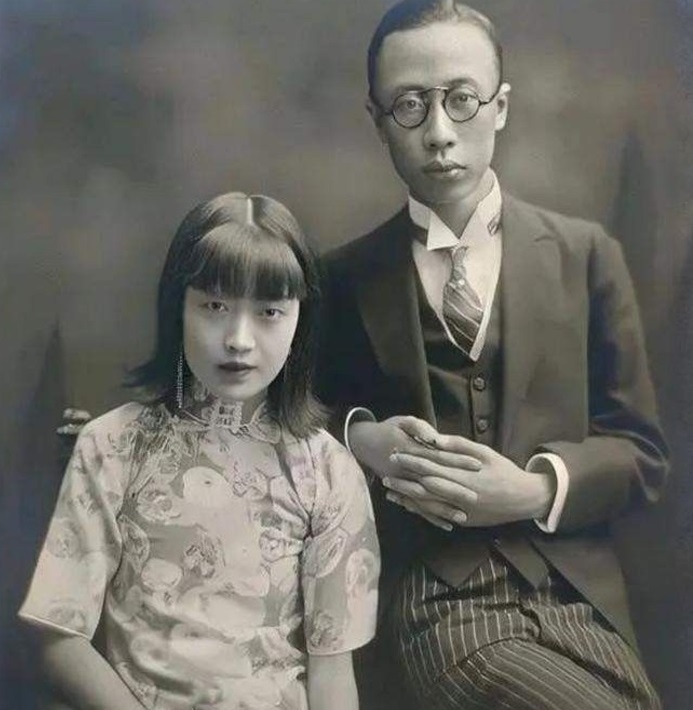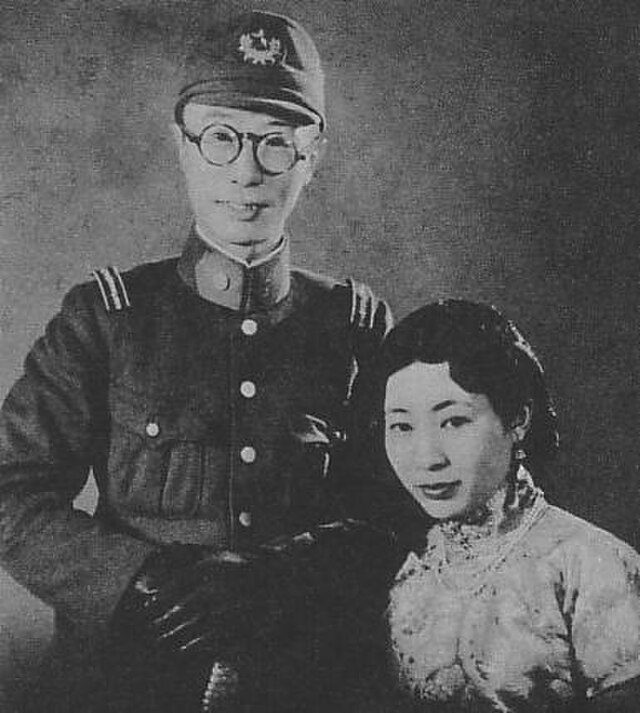【1. The Early Life of Empress Wanrong】

Wanrong holding hands with Puyi (public domain)
Wanrong was the empress consort of Aisin Gioro Puyi, the last emperor of the Qing dynasty.
She was born on November 13, 1906, into the prestigious Manchu Gobulo family. Her father, Rongyuan, was a senior official of the Qing court, and Wanrong was raised in an environment rich in tradition and ceremony.
Her name, “Wanrong,” was derived from a line in Rhapsody on the Luo River Goddess by Cao Zhi, the fifth son of Cao Cao during the Three Kingdoms period:
“She flits like a startled swan, graceful like a swimming dragon.”
As her name suggests, Wanrong drew attention early in life for her beauty and intellect. Fluent in English and French and well-versed in Western culture, she embodied the ideal of a “Western-style lady” with elegance and education.
Although the Qing dynasty formally ended in 1912, Puyi continued to live within the Forbidden City, maintaining the ceremonial lifestyle of the “former imperial family.”

Hall of Supreme Harmony, Forbidden City (photo by Dave Proffer via Wikimedia Commons)
In 1922, following imperial tradition, a bride selection was held. Wanrong was summoned as a candidate and ultimately chosen to be empress.
She was 17 years old, beginning her life as empress in the former imperial palace of Beijing.
However, in a kingdom that existed only in name, the title of “empress” was nothing more than a fragile dream suspended between grandeur and illusion.
【2. The Empress and the Concubine】

Wenxiu, concubine of Puyi (public domain)
On the same day Wanrong entered the palace as empress, another young girl named Wenxiu, just 12 years old, was also brought in.
Wenxiu was from the Mongol Erdet clan, a noble family with imperial lineage. She was granted the title of Shufei (Noble Consort) and officially became a concubine to Puyi.
Wenxiu had initially been considered a candidate for empress but was passed over due to her family’s decline in status.
Nonetheless, her delicate beauty and intelligence made her stand out, and she quickly gained influence in court.

Empress Wanrong in formal Qing attire (public domain)
While Wanrong held the superior rank, Wenxiu was a source of growing concern. Wanrong, proud of her symbolic title as empress, naturally developed the desire to monopolize the emperor’s affections. This bred resentment toward Wenxiu.
However, Puyi remained emotionally detached and showed no particular favoritism toward either woman.
【3. Expelled from the Forbidden City】
In 1924, amid intensifying power struggles among northern warlords, General Feng Yuxiang launched a sudden coup in Beijing—a moment known as the “Beijing Coup.”
As a result, Feng seized control of the government and ordered Puyi to vacate the Forbidden City.
Puyi, along with Empress Wanrong and Concubine Wenxiu, relocated to Zhang Garden in Tianjin.

Puyi and Wanrong during their time in Tianjin (public domain)
Isolated from the outside world, tensions began to rise within the household.
Wanrong started distancing herself from Wenxiu, and the rift between them deepened.
In 1931, a dramatic turn of events occurred: Wenxiu escaped from Zhang Garden and filed for divorce in court.
It was the first divorce request ever initiated by a concubine in the history of the Chinese imperial family. The court approved it.
As part of the settlement, Puyi was to pay Wenxiu 55,000 yuan in compensation, and Wenxiu agreed never to remarry.
Puyi, humiliated by this public scandal, suspected that Wanrong had orchestrated the affair behind the scenes.
He grew bitter and began closing his heart to Wanrong.
Wenxiu was stripped of her title of Shufei and demoted to commoner status.
Although she found work as a teacher, she eventually fell into poverty and died in near-starvation in Beijing in 1953.
Although Wanrong nominally retained her status as empress, her marriage was already fractured.
Wenxiu’s departure may have seemed like a victory, but in reality, it only widened the emotional chasm between Wanrong and Puyi.
【4. The Lonely Descent into Opium Addiction】

Wanrong at Tianjin’s Jing Garden residence (public domain)
Life in Tianjin offered little comfort to Wanrong. Puyi, once a fellow admirer of Western culture, had grown cold and indifferent toward her.
Abandoning his dreams of exile abroad, he now focused on restoring his imperial status by becoming the puppet emperor of the Japanese-backed state of Manchukuo.
To Wanrong, this was incomprehensible.
What she longed for was freedom and modern love, not a return to the feudal throne.
With love and trust gone, she became increasingly mentally distressed.
As a means of escape, she turned to opium.
Initially used to ease insomnia and anxiety, she soon became addicted, and her mind and body began to deteriorate rapidly.
Puyi took no steps to intervene. Instead, he emotionally abandoned her.
Wanrong, too, became increasingly difficult for those around her to manage.
Eventually, she was separated even physically from Puyi, left to face her decline in isolation—an empress in name only, trapped in a prison of the mind and body.
【5. The Final Days of Wanrong】

Monument marking the abdication of the Emperor of Manchukuo (public domain)
In 1945, Japan’s defeat led to the collapse of Manchukuo, bringing an end to Puyi and Wanrong’s illusion of an imperial court.
As Japanese troops retreated, Puyi’s family attempted to flee. But Wanrong was too weak to escape.
In the fake palace of Changchun, she had become debilitated from opium addiction and psychological trauma.
She was left behind and eventually transferred to a detention facility in Jilin, where she was treated little better than a prisoner.
There are few reliable records of this period, but testimony suggests she suffered from severe malnutrition and exhaustion.
She wore tattered clothes, didn’t wash her face, her vision deteriorated, and she could no longer stand on her own.
One of the key witnesses to Wanrong’s condition was Hiro Saga, a Japanese noblewoman who had married Puyi’s younger brother, Pujie.

Aisin Gioro Pujie and Hiro Saga in 1938 (public domain)
Hiro Saga, as the “Princess of Manchukuo,” had regular contact with Wanrong.
In her memoir, she wrote of Wanrong’s time in the Jilin prison:
“The Empress would scream and groan as if in madness all day long, rolling on the wooden floor and contorting in agony. She still fed herself, but she could no longer manage to use the toilet on her own.”
— From The Last Princess of Manchukuo, Chapter 5
Saga recalled how soldiers and guards gathered to gawk at Wanrong’s suffering, describing the scene as “like a zoo—utterly heartbreaking.”
Her dignity, beauty, and status as empress had all faded.
Reduced to less than a prisoner, Wanrong’s life quietly ebbed away.
In 1946, she died in Jilin at the age of 40.
There are almost no official records of her death.
According to multiple accounts, her body was not placed in a coffin but wrapped in a worn kangxi (traditional mat) and buried in the mountains.
Once celebrated as a peerless beauty and empress of China, she died alone, forgotten, and abandoned to the earth.
【Epilogue】

Puyi in custody, escorted by Soviet officers (August 9, 1946, public domain)
Puyi, on the other hand, was captured by the Soviet army. After internment in Siberia, he was handed over to the People’s Republic of China and imprisoned as a war criminal.
Later granted amnesty, he lived as an ordinary citizen and wrote his memoir From Emperor to Citizen, which became the basis for the film The Last Emperor.
Yet in that memoir, he rarely mentioned Wanrong.
His story centered on “himself as emperor”—not on the empress who shared his downfall.
Wanrong longed for love but was denied it.
She bore imperial authority but was never protected by it.
The Western-style romance and empress’s glory she dreamed of—none of it was real.
She rose and fell with the last days of the Qing dynasty.
And in the echoes of a vanished empire, the tragedy of Wanrong endures.
References: Qing History Draft, From Emperor to Citizen by Puyi, The Last Princess of Manchukuo by Hiro Saga


